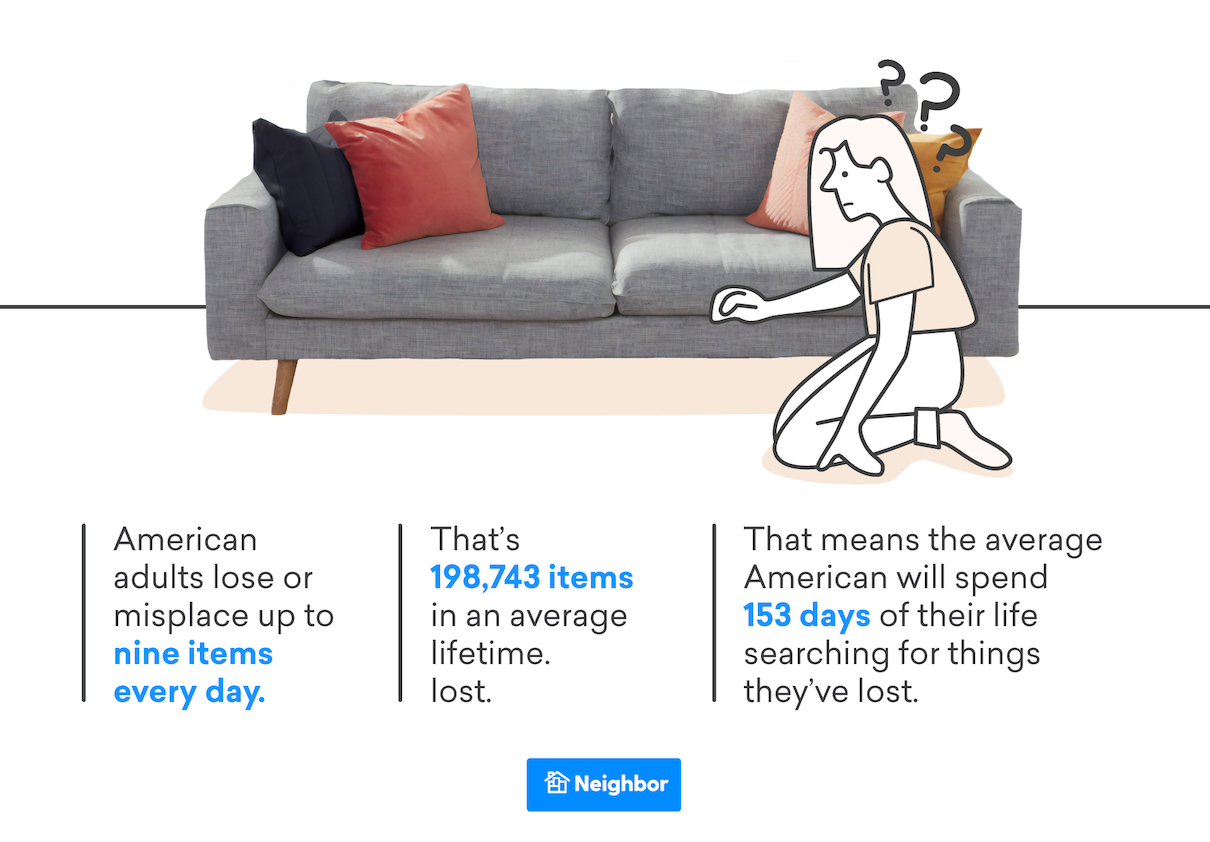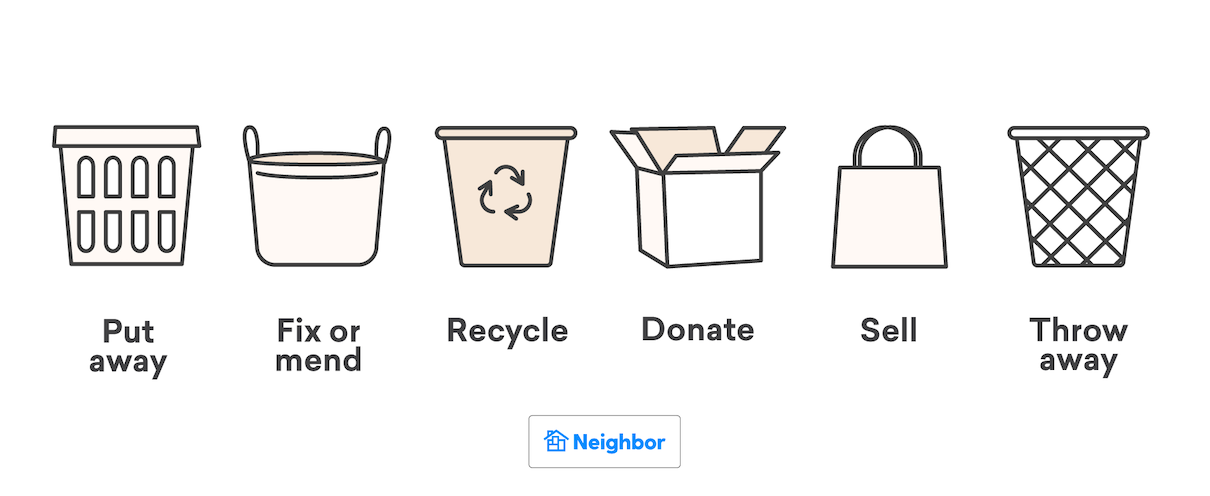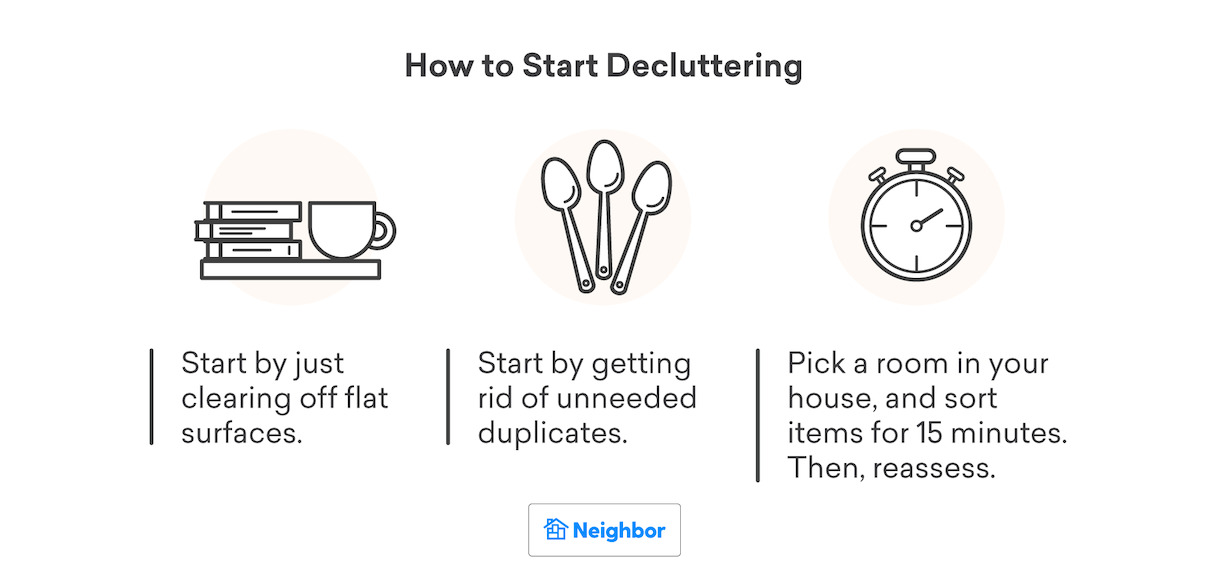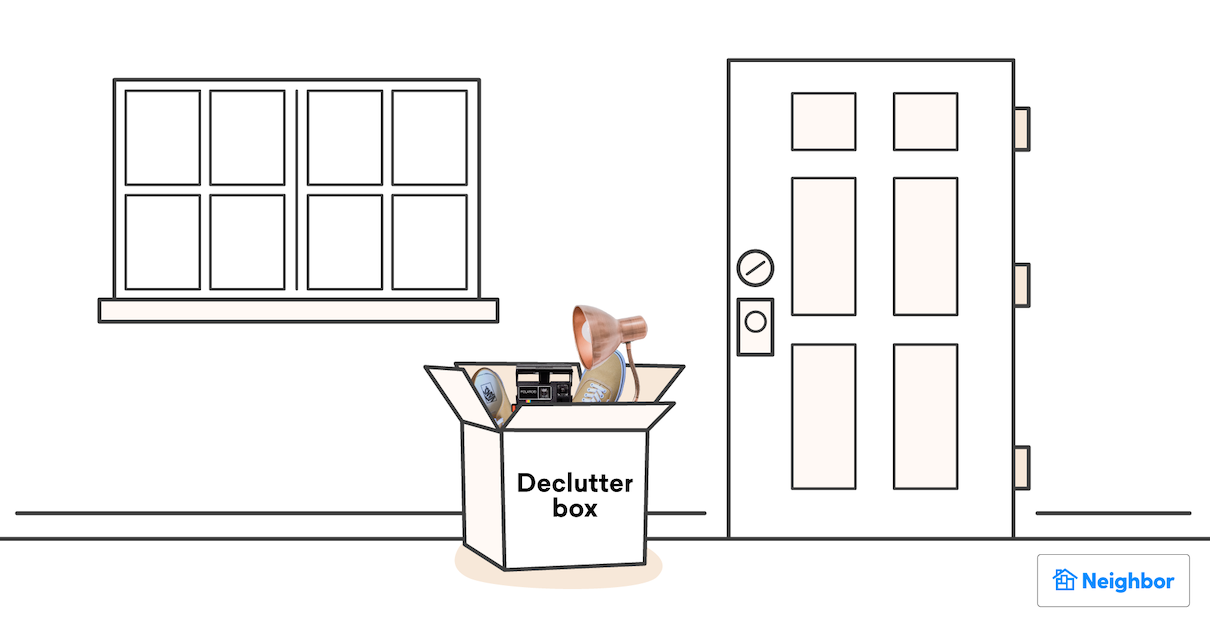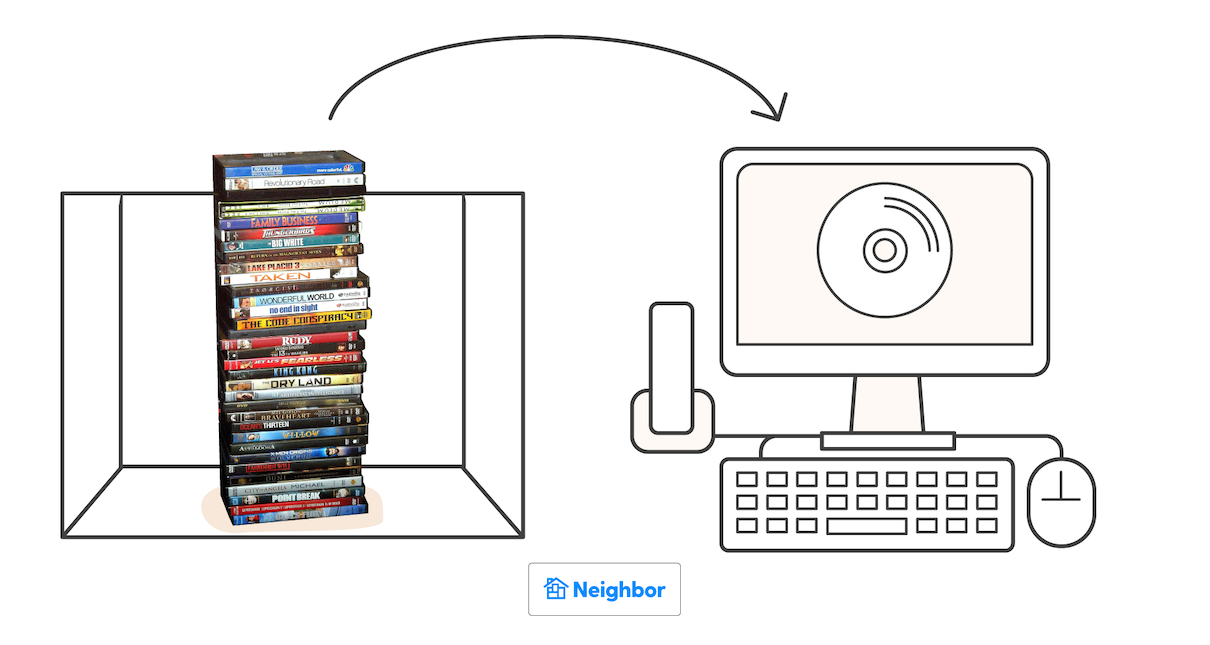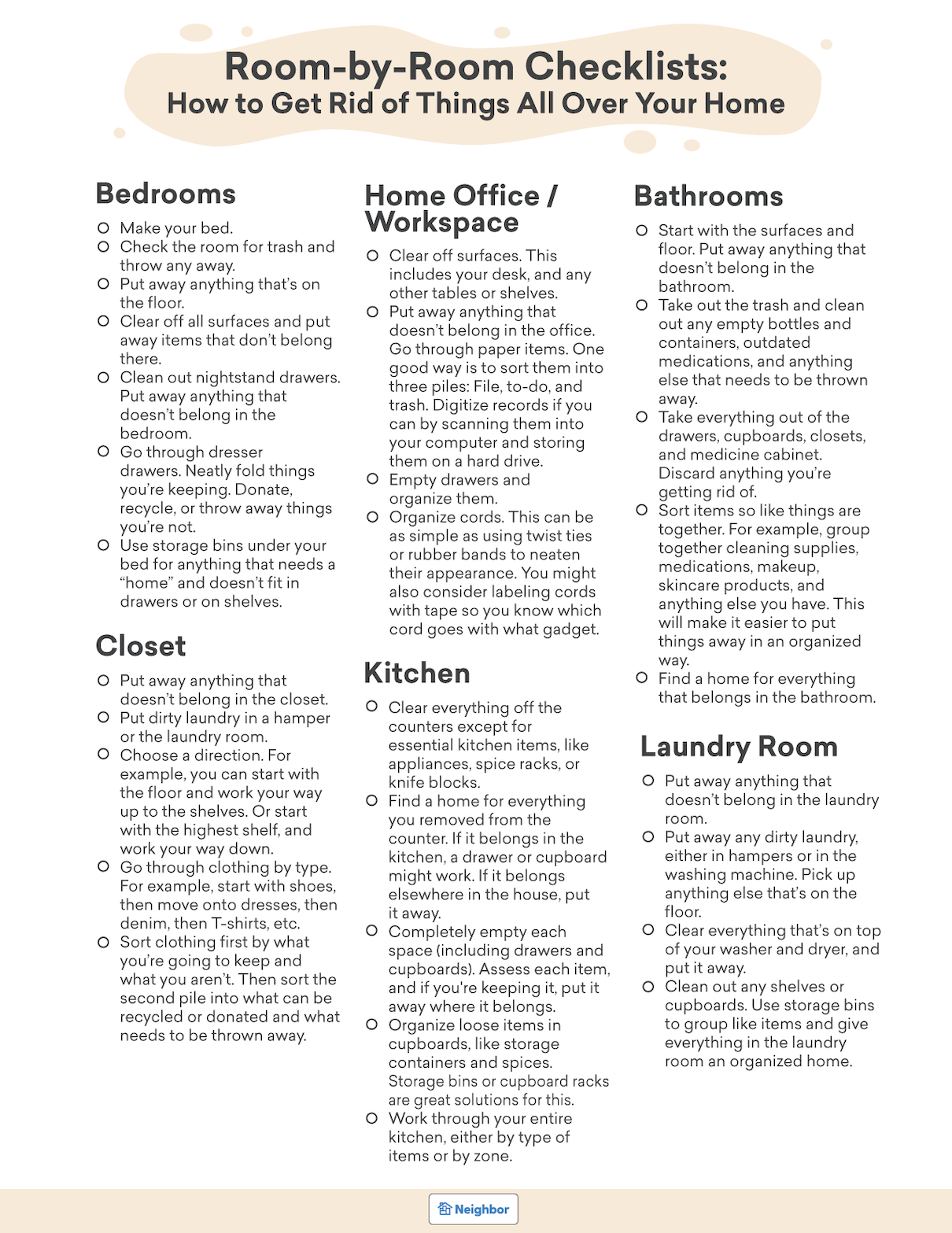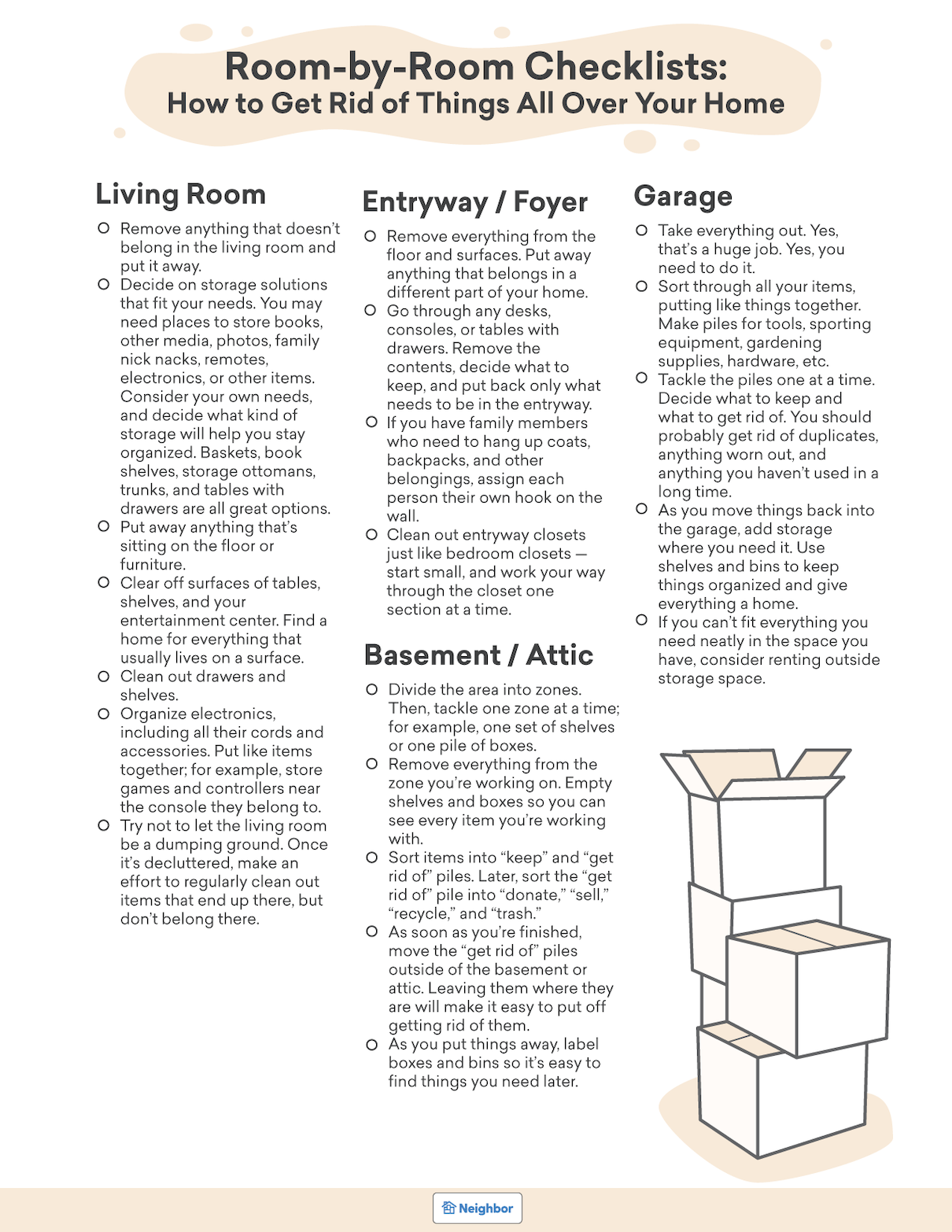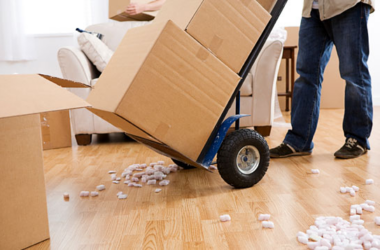Marie Kondo, one of the most prolific organizers of our time, might just have the best advice for how to get rid of things:
“Can you truthfully say that you treasure something buried so deeply in a closet or drawer that you have forgotten its existence? If things had feelings, they would certainly not be happy. Free them from the prison to which you have relegated them. Help them leave that deserted isle to which you have exiled them.”
Kondo has a point. Most of us have too many belongings — so many that some of them inevitably live in the back of a drawer or on a garage shelf where we hardly remember we have them, let alone use them on a regular basis.
But despite Kondo’s often rosy view of decluttering, it’s not an easy process for many people. In fact, the LA Times found that the average American home contains around 300,000 items. And according to the Wall Street Journal, Americans spend $1.2 trillion each year on nonessential goods — meaning things they don’t need.
Still, there are real benefits to reducing the clutter. A 2012 study of 3,000 adults found that we lose or misplace up to nine items every day — or 198,743 in an average lifetime, resulting in 3,680 hours or 153 days spent searching for things we misplaced. Cutting down on clutter not only saves money on things you would otherwise buy, but it saves time — a decluttered house will make it easier to find things you’re looking for, and will be faster to clean and organize.
If you’re ready to start on your own decluttering journey, this is the ultimate guide you need. From tips for making a game plan and strategies for room-by-room declutters, to tips from organizational experts, this is everything you need to remove nonessential belongings from your space. Ready to learn how to get rid of things? Let’s get started.
- Tips to Start Decluttering
- Decluttering Secrets for Small Spaces
- Room-by-Room Decluttering Checklist + Printables
- Decluttering Inspiration from Experts
How to Get Rid of Things: Tips to Start Decluttering
The best decluttering jobs begin with a plan. That is to say, rather than just jumping in and starting to get rid of things, you’ll benefit from laying some groundwork first. These steps should help.
Start with Your Mindset
Before even beginning ask yourself this question: Why do you want to learn how to get rid of things in the first place? Examine your motivations for decluttering. It might help to write them down somewhere (even if it’s just in a note on your phone) so you can refer back to them when you need a little extra motivation.
As you’re preparing your mindset for decluttering, also think about what might block you from finishing the job. Being prepared for your challenges will help you face them later.
And remember — if you’re even thinking about decluttering, it means this simple fact is true in your life: You have more than enough things. When it gets difficult to part with items, try to remember that truth.
Think About Your End Goal
Not everyone wants the same results from decluttering. Before you start, it’s a good strategy to think about your end goal.
Once you know what you want to accomplish in the long run, break your end goal into smaller goals you can achieve along the way. Give yourself plenty of time for the job, and set reasonable expectations for what you can get done at once depending on how much time and energy you have to put toward decluttering.
The 80/20 Rule
There’s a rule about clothes called the 80/20 rule. What it says is that most people tend to spend 80 percent of their time wearing only 20 percent of what’s in their closet.
We think this rule also applies pretty well to other belongings. If you’re ever feeling overwhelmed by getting rid of a lot of things, remind yourself that 80 percent of the time, you only use about 20 percent of the things you own.
Decide What to Do With Unwanted Items
It’s a good idea before you get started to have a game plan in place for what you’ll do with items you decide to get rid of.
For this, you’ll want to consider what resources are available in your area. Is it possible to recycle different materials and large items? Do you have a way to transport donated items to a drop-off location?
And, of course, you won’t do the exact same thing with every item you decide to part with. So organization experts recommend creating a sorting system. Designate different areas for items you plan to:
- Put away
- Fix or mend
- Recycle
- Donate
- Sell
- Throw away
Take “Before” Photos
Before starting, take photos of all the areas of your home that you plan to declutter. This serves two purposes:
- First, seeing the areas in photos might help you see clutter you don’t notice otherwise.
- And having photos from before you began your decluttering journey can be a great motivator if you need inspiration to keep going later on.
Choose a Place to Begin
And finally, choose where you’ll start. It’s a good idea to start small, and we have more advice on that below. But the most important thing is to pick somewhere and get started.
Decluttering Secrets From Small-Space Dwellers
You’re ready to start decluttering!
The people who know best how to get rid of things are often those who live in small spaces, so we’ve compiled some of their best decluttering advice to help you get started.
Start Simple
If you’re facing an entire home in need of decluttering, it likely feels like a monumental, overwhelming task. That’s why it’s important to start small. Here are a few achievable first goals organization experts recommend:
- Start with flat surfaces. Just clean off tabletops and counters.
- Start with duplicates. If you have multiples of a certain item, get rid of the extras.
- Start with just 15 minutes. If you’re really not sure how to start small, just pick a room in your house, set a timer for 15 minutes, and see how you feel at the end.
Just 10 Things
Another great tip that professional organizers recommend is to make your first goal just getting rid of 10 things. They can be from anywhere in your home. Just pick 10 items you don’t want or need, and get rid of them.
Try a “Power Purge”
For some people, the idea of gradually decluttering your home over time will feel like a chore that never ends. If you’d rather get the whole job done quickly, how about what organization experts call a “power purge?”
The basic idea is that you’ll clear your schedule and set aside time to do all your decluttering in one go. That might mean just keeping a whole weekend open to spend two days in intense decluttering mode, or it might mean taking some time off work for a decluttering staycation. Make a plan that works with your schedule.
Use a Decluttering “Snowball” Method
For other people, the idea of trying to declutter the entire house in just a few days might be prohibitively overwhelming. That’s OK too! You can always take your time and get the job done at your own pace.
One great technique is called the “snowball” method. This means that on the first day, you’ll get rid of one item. On the second day, you’ll get rid of two items. On the third, day, three items, and so on. This allows you to start slow, and it’s surprisingly effective — after snowballing for just one week, you’ll have gotten rid of 28 things. And if you keep it up for 30 days, you’ll declutter a pretty astounding 465 items from your home.
Declutter Every Single Day
If you’re really not worried about finishing the job by a specific deadline, you can just take the one-item-a-day approach. Every day, get rid of one thing. That means 365 things will be gone by the end of a year.
Keep a Box by the Front Door
One tip many organization experts recommend is keeping a box by your front door for items you don’t want or need. Whenever you encounter an item around the house you’d like to get rid of, put it in the box. When the box is full, recycle, donate, or give away the contents, and then start over.
Don’t Spend More than 5 Minutes on an Item
As you get deeper into decluttering, you might start to encounter items that are harder to let go of. Experts recommend never spending more than five minutes on any one item. Instead, create a “maybe” pile. Place items there when you get stuck, sleep on the decision, and come back to them later.
Don’t Think About Sunk Costs
One of the biggest challenges for many people when decluttering is that they get hung up on the idea of sunk costs — that is, they don’t want to get rid of things, because then the money they originally spent on those items has gone to waste.
Try to break out of this mindset. Instead, think about the money you’ll save now that you’ve embraced a more minimalist lifestyle. Or think about the time you’ll save not having to clean and organize a house full of items you don’t need. Time is money, after all.
Make a Plan for Broken Things
If you’re like most Americans, you’re probably hanging onto some things that are broken or in need of mending — and have been for a long time. Are you actually going to get them fixed?
Now’s the time to make those plans. If you’re going to get broken things fixed, do it now. Otherwise, it’s time to let go of things that don’t work properly and are just gathering dust in your home.
Think About When You Last Used Things
One helpful way to decide whether to keep an item or get rid of it is to think about when you last used it. If it’s been months or years, that’s a pretty good indication it’s something you should get rid of.
For people who want to declutter their homes over a long period of time, there’s a great trick for this: Keep track of everything you use for the next year. With clothes, you can do this by turning all their hangers backward, and setting them straight again once you’ve worn an item. With other items, you can put stickers on things that you remove once you’ve used something. At the end of the year, look at which hangers are still facing the wrong way, and what items still have stickers on them. You can probably get rid of those things.
Ask Yourself If You Love It
This is advice straight from Marie Kondo, who says that in order to keep items, you should “feel a spark of joy” when you touch them. If you’re on the fence about something, ask yourself if you love it. If the answer is yes, keep it without any guilt. If the answer is no, it might be something you want to part with.
For items you don’t love but still can’t decide on, ask yourself another question: “Does this add value to my life?” If you don’t love it but it does add value, it’s a good candidate for keeping. If you answered no to both questions, you should probably let it go.
Digitize Items When You Can
One of the great things about the digital age is that where people once had to have huge shelves to store all their books, movies, and music — now, all those things can live in digitized formats on a hard drive.
This can also be a great strategy for sentimental items. Maybe it’s tough to part with things like clothing from special events, but what if you made a photo album of those items instead, that you could look through when you wanted to remember them?
Give Every Item Its Own “Home”
As you get further along in your decluttering journey, start giving every item in your home its own place to “live.” When everything has somewhere it belongs, it’s much faster and easier to clean up, meaning you won’t lose the progress you’ve made so far.
Make Decluttering Fun
Try to find small ways to make the decluttering process enjoyable for yourself. Play your favorite music while you clean or sort items. Have friends over to help out. Set rewards for yourself — for example, once the linen closet is cleaned out and organized, you can see that new movie you’ve been looking forward to.
Have Someone Hold You Accountable
A great way to stay on track is to share your decluttering goals with someone who can help hold you accountable for making progress. Social media can be a great tool for this.
Just Say “No” To Free Items
As humans, we’re easily tempted by giveaways and freebies. But are the t-shirts and drink koozies being handed out at that event really things you need? You’re working so hard to declutter, so practice saying no to free things that will add more clutter.
Pace Yourself
Remember that not everyone will be able to declutter their entire house in a short period of time. And maintaining a clutter-free lifestyle is definitely a marathon, not a sprint.
Take breaks when you need to. Don’t beat yourself up because progress is slow — celebrate that you’re making progress at all. And if you find yourself needing a boost of inspiration to keep going, refer back to the goals you made before you started, or look at your “before” photos to see how far you’ve come.
Remember All the Work Will Be Worth It in the End
Decluttering is hard. So is keeping up a clutter-free lifestyle once you’re done. But stick with it — it’ll all be worth it in the end.
Room-by-Room Checklists: How to Get Rid of Things All Over Your Home
If you’re decluttering your home one room at a time, it might be helpful to have room-by-room checklists for how to get rid of things.
Every home is different and has different decluttering needs, so these lists are far from comprehensive. Instead, think of them as starting points that will help you build up the momentum you need to completely declutter every room in your home.
Download a PDF copy of Neighbor’s Decluttering Your Home Checklist
Getting Started Decluttering Bedrooms
Bedrooms are some of the areas that tend to be neglected, since they’re more private spaces you may not clean before guests come over. But everyone deserves a tidy, peaceful bedroom. Start with this list to be on your way toward a clutter-free bedroom.
- Make your bed.
- Check the room for trash and throw any away.
- Put away anything that’s on the floor and shouldn’t be.
- Clear off all surfaces and put away items that don’t belong there.
- Clean out nightstand drawers.
- Put away anything that doesn’t belong in the bedroom.
- Go through dresser drawers. Neatly fold things you’re keeping. Donate, recycle, or throw away things you’re not.
- Use storage bins under your bed for anything that needs a “home” and doesn’t fit in drawers or on shelves.
Next, Tackle the Closet
The closet gets its own list, because for many people, closets are easy to let become disorganized behind their closed doors. Here are some tips for getting your closets back in shape.
- Put away anything that doesn’t belong in the closet.
- Put dirty laundry in a hamper or the laundry room.
- Choose a direction. For example, you can start with the floor and work your way up to the shelves. Or start with the highest shelf, and work your way down.
- Go through clothing by type. For example, start with shoes, then move onto dresses, then denim, then T-shirts, etc.
- Sort clothing first by what you’re going to keep and what you aren’t. Then sort the second pile into what can be recycled or donated and what needs to be thrown away.
How to Get Rid of Things In Your Home Office or Workspace
Studies show people are more productive when they work in a clean, tidy environment. That’s just one good reason to declutter your home office or workspace. Here’s how to get started.
- Clear off surfaces. This includes your desk, and any other tables or shelves.
- Put away anything that doesn’t belong in the office.
- Go through paper items. One good way is to sort them into three piles: File, to-do, and trash. Digitize records if you can by scanning them into your computer and storing them on a hard drive.
- Empty drawers and organize them.
- Organize cords. This can be as simple as using twist ties or rubber bands to neaten their appearance. You might also consider labeling cords with tape so you know which cord goes with what gadget.
First Steps for Decluttering Your Kitchen
The kitchen is likely a major decluttering challenge in a lot of homes. But it’s important to keep your kitchen as clean as possible — that’s where you prepare the food you eat. If you’re not sure how to get started, use this checklist to build up the momentum you need to achieve a clutter-free kitchen.
- Clear everything off the counters except for essential kitchen items, like appliances, spice racks, or knife blocks.
- Find a home for everything you removed from the counter. If it belongs in the kitchen, a drawer or cupboard might work. If it belongs elsewhere in the house, put it away.
- Completely empty each space (including drawers and cupboards). Assess each item, and if you’re keeping it, put it away where it belongs.
- Organize loose items in cupboards, like storage containers and spices. Storage bins or cupboard racks are great solutions for this.
- Work through your entire kitchen, either by type of items (ex. Cookware, silverware, and appliances) or by zone (drawers and cupboards).
How to Start Decluttering Your Bathrooms
A tidy bathroom is definitely preferably over the alternative. Here’s how to get started if your bathroom needs decluttering.
- Start with the surfaces and floor. Put away anything that doesn’t belong in the bathroom.
- Take out the trash and clean out any empty bottles and containers, outdated medications, and anything else that needs to be thrown away.
- Take everything out of the drawers, cupboards, closets, and medicine cabinet.
- Discard anything you’re getting rid of.
- Sort items so like things are together. For example, group together cleaning supplies, medications, makeup, skincare products, and anything else you have. This will make it easier to put things away in an organized way.
- Find a home for everything that belongs in the bathroom.
Cleaning Out a Cluttered Laundry Room
Since the laundry room is a part of the house where you take dirty things on purpose, it’s easy for it to get cluttered. Here’s how to battle laundry room clutter.
- Put away anything that doesn’t belong in the laundry room.
- Put away any dirty laundry, either in hampers or in the washing machine. Pick up anything else that’s on the floor.
- Clear everything that’s on top of your washer and dryer, and put it away.
- Clean out any shelves or cupboards. Use storage bins to group like items and give everything in the laundry room an organized home.
How to Get Rid of Things in the Living Room
The living room is likely where you and your family spend a lot of time, which means it’s a lightning rod for clutter. Here’s how to get started cleaning up this space.
- Remove anything that doesn’t belong in the living room and put it away.
- Decide on storage solutions that fit your needs. You may need places to store books, other media, photos, family nick nacks, remotes, electronics, or other items. Consider your own needs, and decide what kind of storage will help you stay organized. Baskets, book shelves, storage ottomans, trunks, and tables with drawers are all great options.
- Put away anything that’s sitting on the floor or furniture.
- Clear off surfaces of tables, shelves, and your entertainment center. Find a home for everything that usually lives on a surface.
- Clean out drawers and shelves.
- Organize electronics, including all their cords and accessories. Put like items together; for example, store games and controllers near the console they belong to.
- Try not to let the living room be a dumping ground. Once it’s decluttered, make an effort to regularly clean out items that end up there, but don’t belong there.
Decluttering an Entryway or Foyer
Another common spot for families to amass a lot of clutter is the entryway or foyer, which serves as a drop zone for people once they get home from school or work. Ready to reduce clutter in this high-traffic area? Here’s how to get started.
- Remove everything from the floor and surfaces. Put away anything that belongs in a different part of your home.
- Go through any desks, consoles, or tables with drawers. Remove the contents, decide what to keep, and put back only what needs to be in the entryway.
- If you have family members who need to hang up coats, backpacks, and other belongings, assign each person their own hook on the wall.
- Clean out entryway closets just like bedroom closets — start small, and work your way through the closet one section at a time.
- No matter how small your entryway is, the best way to make it feel open and functional is to keep it free of clutter. Revisit this space often.
Cleaning Out Your Basement or Attic
Since they’re often areas that are meant for storage and out of daily view, basements and attics tend to get packed with unneeded items pretty quickly. It’s not an easy job, but here’s how to reduce clutter in these spaces.
- Divide the area into zones. Then, tackle one zone at a time; for example, one set of shelves or one pile of boxes.
- Remove everything from the zone you’re working on. Empty shelves and boxes so you can see every item you’re working with.
- Sort items into “keep” and “get rid of” piles. Later, sort the “get rid of” pile into “donate,” “sell,” “recycle,” and “trash.”
- As soon as you’re finished, move the “get rid of” piles outside of the basement or attic. Leaving them where they are will make it easy to put off getting rid of them.
- As you put things away, label boxes and bins so it’s easy to find things you need later.
How to Get Started Decluttering a Garage
Just like basements and attics, garages seem to attract boxes and bins of things we don’t need. Here’s how to start clearing out your garage.
- Take everything out. Yes, that’s a huge job. Yes, you need to do it.
- Sort through all your items, putting like things together. Make piles for tools, sporting equipment, gardening supplies, hardware, etc.
- Tackle the piles one at a time. Decide what to keep and what to get rid of. You should probably get rid of duplicates, anything worn out, and anything you haven’t used in a long time.
- As you move things back into the garage, add storage where you need it. Use shelves and bins to keep things organized and give everything a home.
- If you can’t fit everything you need neatly in the space you have, consider renting outside storage space.
Once you’ve made your way through all the rooms in your home, remember that decluttering is a continuous process. Keep these tips handy to prevent clutter from creeping back in and undoing all your hard work.
Decluttering Inspiration: 4 Expert Tips on How to Get Rid of Things
Like we’ve already said, decluttering and organizing is a marathon, not a sprint. This is a long term process that you’ll likely need to repeat again later — and it’s not uncommon to feel burnt out during the process.
So if you need some inspiration to help you reach your decluttering goals, take it from these four organization experts.
Joshua Becker
As the mind behind the popular blog Becoming Minimalist, Becker has plenty of advice to offer someone just learning how to get rid of things. But we particularly love his views on why you should make decluttering a regular part of your life.
“My belongings were not adding value to my life,” he explained after telling a story of spending a beautiful Saturday cleaning out his garage instead of spending time with his daughter — what he really wanted to do. “Instead, they were subtracting from it.”
Not getting value from your own things? Follow Becker’s advice and let your belongings go.
Gretchen Rubin
https://www.instagram.com/p/BuWyeLMADIT/
Rubin might be best known for her 2019 manifesto, Outer Order, Inner Calm (and if you need serious cleaning inspiration, we recommend giving it a read).
But what Rubin also understands is how hard this process can be. She knows what a monumental undertaking it is. When you feel discouraged, consider Rubin’s acknowledgment of just how difficult it can be to clean: “A friend once told me, ‘I finally cleaned out my fridge, and now I know I can switch careers,’ and I knew exactly how that felt.”
Clea Shearer and Joanna Teplin
https://www.instagram.com/p/B7cgUgfBXep/
Even though it’s tough, though, organization should always help bring more joy into your life. For that inspiration, we turn to a simple message from Clea Shearer and Joanna Teplin, creators of The Home Edit: “Organizing should be fun!” If you’re totally miserable during the process, take their advice: Put on some music, invite friends over to help, or promise yourself a tempting reward once the job is finished to bring more joy to your decluttering journey.
Marie Kondo
https://www.instagram.com/p/B6vq2FjAP8h/
And for the ultimate inspiration to declutter, we come full circle, back to Marie Kondo, who sparked a decluttering revolution for our generation.
“To truly cherish the things that are important to you,” she says, “you must first discard those that have outlived their purpose. To throw away what you no longer need is neither wasteful nor shameful.”
Take that advice as you move through your decluttering journey. It’s OK to let things go — in fact, to make any progress, you have to.

